Carrier® HVAC age
How to determine the date of production/manufacture or age of Carrier® brand HVAC Systems.
The industry average service design life for most forced air furnaces is 15-20 years, and the industry average service design life for most air conditioning condensing units is 10-15 years. The average service design life of boilers can vary from as little as 10 years to as many as 50 years depending on the type and quality of materials used in their manufacture. Routine upkeep/maintenance, regional weather/climate, and location/placement of the mechanical systems will all play critical roles in the longevity of these systems.
See also: Estimated Useful Service Life Expectancies
Parent Company: Carrier Global Corporation
Subsidiaries or other related brands: Carrier | Bryant | Payne | BDP | ICP | Airquest | Arcoaire | Comfortmaker | Day & Night | Heil | KeepRight | TempStar | Aquazone | Resco | Weathermaster | Lincoln (formerly) | and manufacturer for Kenmore brand heating and air systems
Example serial number styles/formats found:
- Style 1: 4006A17330
- Style 2: 850304091
- Style 3: W4D14008 (U.S.) ~or~ 4WD14008 (Canada)
- Style 4: A167890
- Style 5: 6###### (U.S.) ~or~ 6#### (Canada)
- Style 6: 46U152456 or 2W13270 (one or two digits followed by a letter) Bryant & Carrier
Legend: Year is RED; Month is GREEN; Week is BLUE
Style 1: 4006A17330
This is the newest style for Carrier brand (or subsidiary) systems, and the age can be determined by the first four numbers.
The serial number style has been used since 1980, and is formatted by 4 numbers, a letter, then 5 numbers. A manufacture date is also often (but not always) included near the bottom of the data/rating tag or directly below the serial number.
CAUTION: This style can easily be confused with Lennox serial number styles, which could potentially lead to an incorrect manufacture date.
Year of manufacture can be determined by using the 3rd & 4th positions of the serial number
Week of manufacture can be determined by using the 1st & 2nd positions of the serial number
This style of serial number has been used exclusively since 1980.
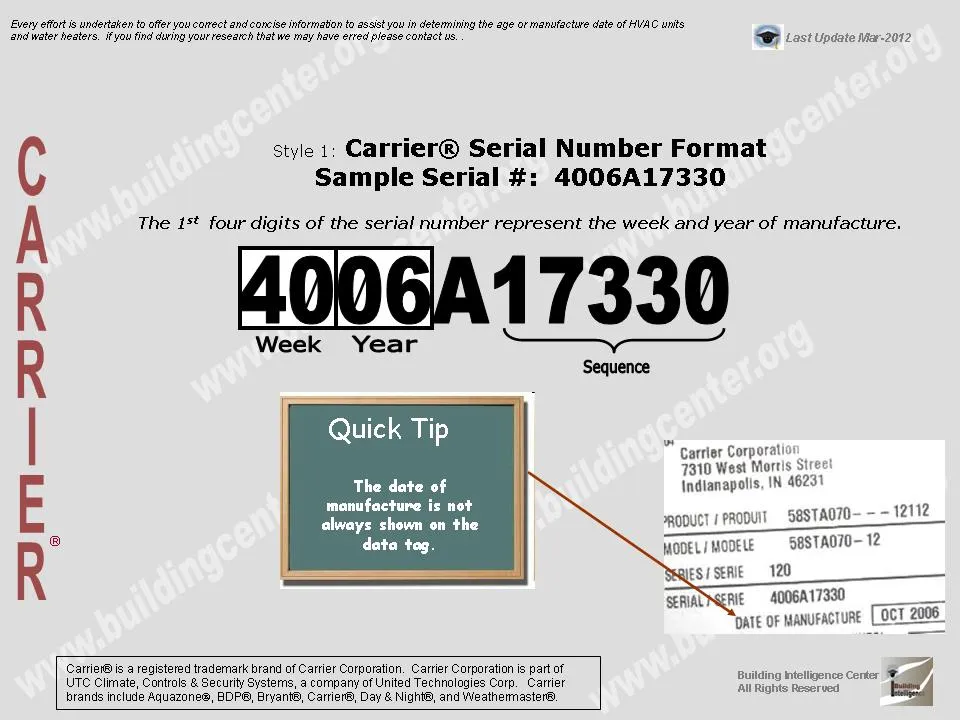
Style 2: 850304091
This is a Bryant or BDP brand style number (merged with Carrier in 1955 and BDP created in 1974). The age can be determined by the first four numbers.
The serial number style was used primarily during the 1980's, and is formatted by a 9 character, all numerical serial number.
Year of manufacture can be determined by using the 1st & 2nd positions of the serial number
Month of manufacture can be determined by using the 3rd & 4th positions of the serial number
This style of serial number was primarily used by Bryant/BDP (subsidiary of Carrier) during the 1980's.
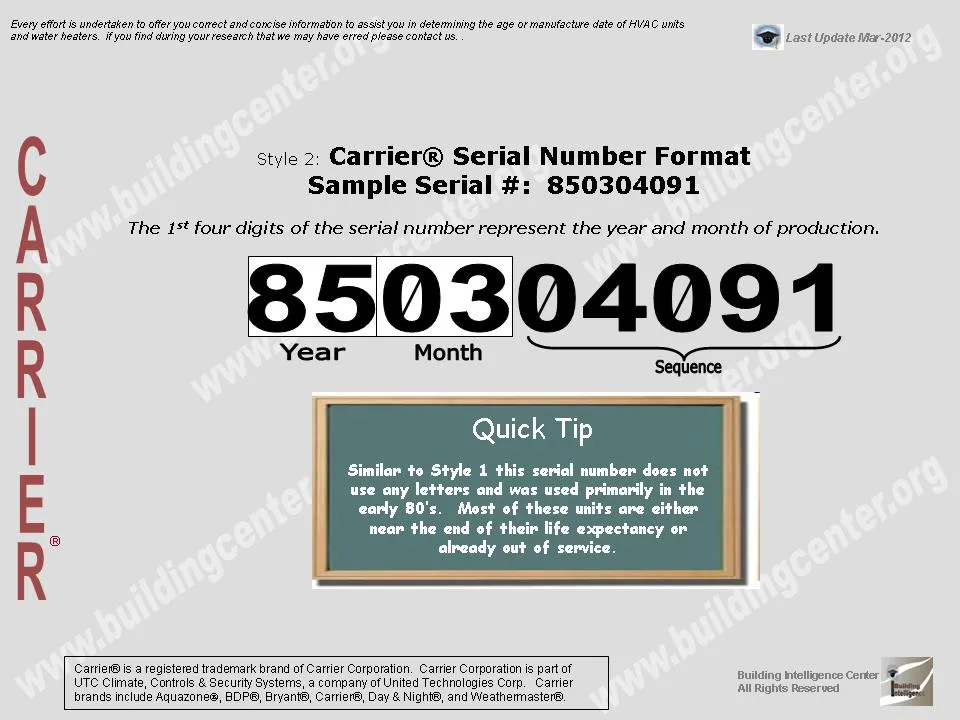
Style 3: W4D14008 (U.S.) ~or~ 4WD14008 (Canada)
The serial number style was used exclusively from 1980-1984 and ONLY used letters M through Z to represent the month.
CAUTION: Canada units reverse the Year and Month positions from U.S. made serial number styles.
Description:
U.S. Systems: Eight (8) character serial number beginning with letters from M to Z. Formatted by one (1) letter (M-Z) followed by one (1) numerical digit and then ends with six (6) more characters (all numerical digits, or letter and digits).
Year of manufacture can be determined by using the 2nd position of the serial number (See chart below)
Month of manufacture can be determined by using the 1st position of the serial number (See chart below)
Canadian Systems: Eight (8) character serial number beginning with a numerical digit, then letter from M to Z. Formatted by one (1) numerical digit, followed by one (1) letter (M-Z) and then ends with six (6) more characters (all numerical digits, or letter and digits).
Year of manufacture can be determined by using the 1st position of the serial number (See chart below)
Month of manufacture can be determined by using the 2nd position of the serial number (See chart below)
This style of serial number was primarily used during the 1980's by BDP (Carrier subsidiary).
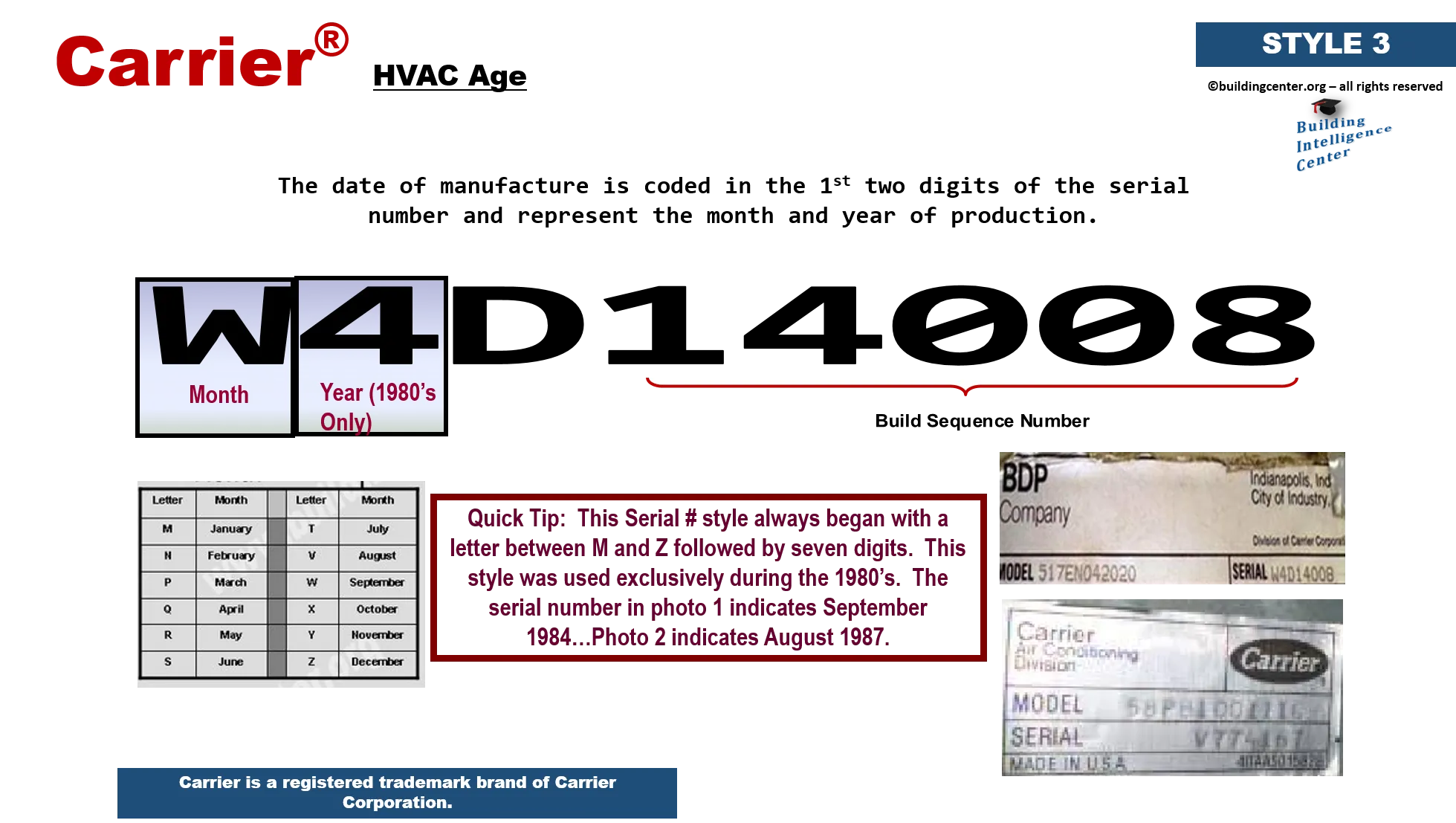
Style 4: A167890
The serial number style was used exclusively from January 1, 1969 to December 31, 1979.
Description: Seven (7) character serial number started with letters from A to L. Formatted by one (1) letter (A-L) followed by one (1) numerical digit (using 0-9) and then ends with five (5) numerical digits.
Year of manufacture can be determined by using the 2nd position of the serial number (See chart below)
Month of manufacture can be determined by using the 1st position of the serial number (See chart below)
This style of serial number was exclusively from January, 1969 through December, 1979.
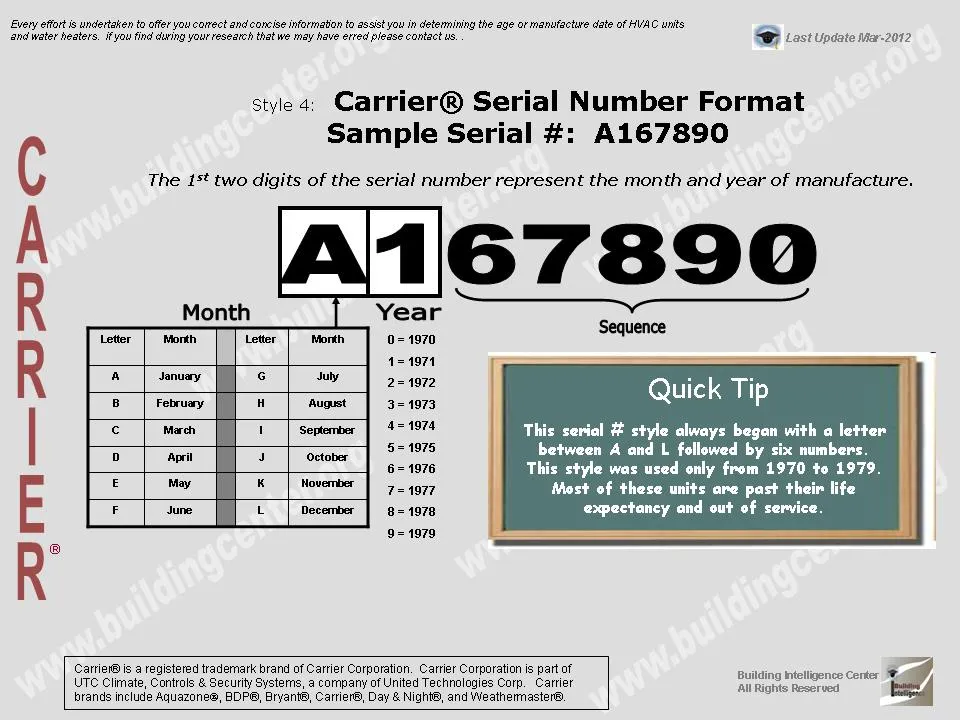
Style 5: 6###### (U.S.) ~or~ 6#### (Canada)
The serial number style was used exclusively PRIOR to 1969
Description:
U.S. Only: Seven (7) character all numeric serial number.
Canada Only: Five (5) character all numeric serial number.
Year of manufacture can be determined by using the 1st position of the serial number
This style of serial number was exclusively PRIOR to 1969.
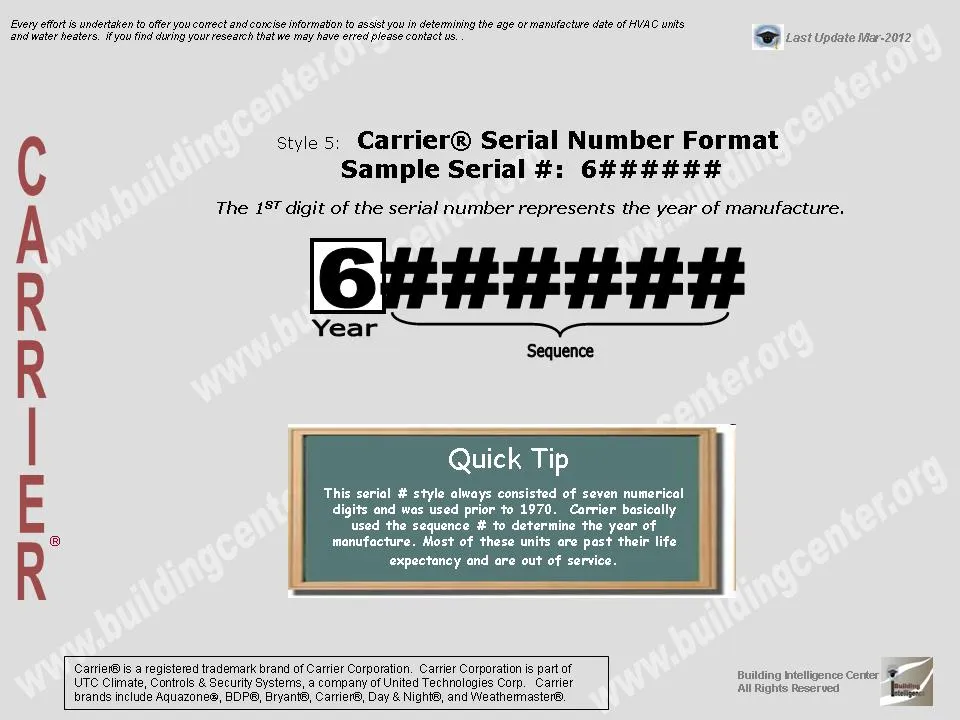
Style 6: 46U152456 or 2W13270 (one or two digits followed by a letter) Bryant & Carrier
Description: Seven (7) to nine (9) character serial number - always beginning with a 1 or 2 digit number followed by a letter. This style was used from 1960 to 1979.
Year of manufacture can be determined by using the 1st letter (2nd or 3rd position) of the serial number: beginning with L and cycling through to end with H (skipping letters O, Q, and Z) representing 1960 - 1979 - See Chart
Week of manufacture can be determined by using the 1st -or- 1st & 2nd positions (number/s) of the serial number: 1-52 representing weeks of the year
Letter - YEAR
- L - 1960
- M - 1961
- N - 1962
- P - 1963
- R - 1964
Letter - YEAR
- S - 1965
- T - 1966
- U - 1967
- V - 1968
- W - 1969
Letter - YEAR
- X - 1970
- Y - 1971
- A - 1972
- B - 1973
- C - 1974
Letter - YEAR
- D - 1975
- E - 1976
- F - 1977
- G - 1978
- H - 1979
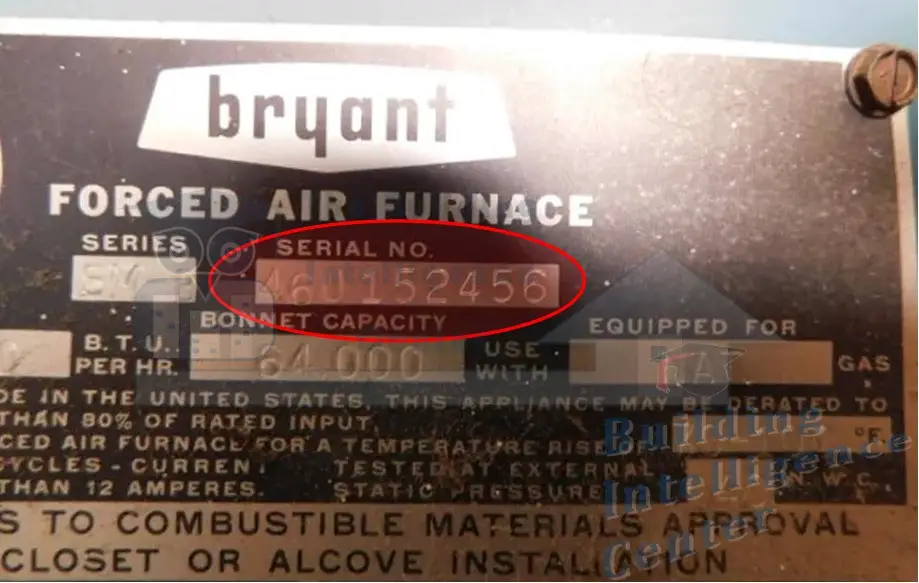
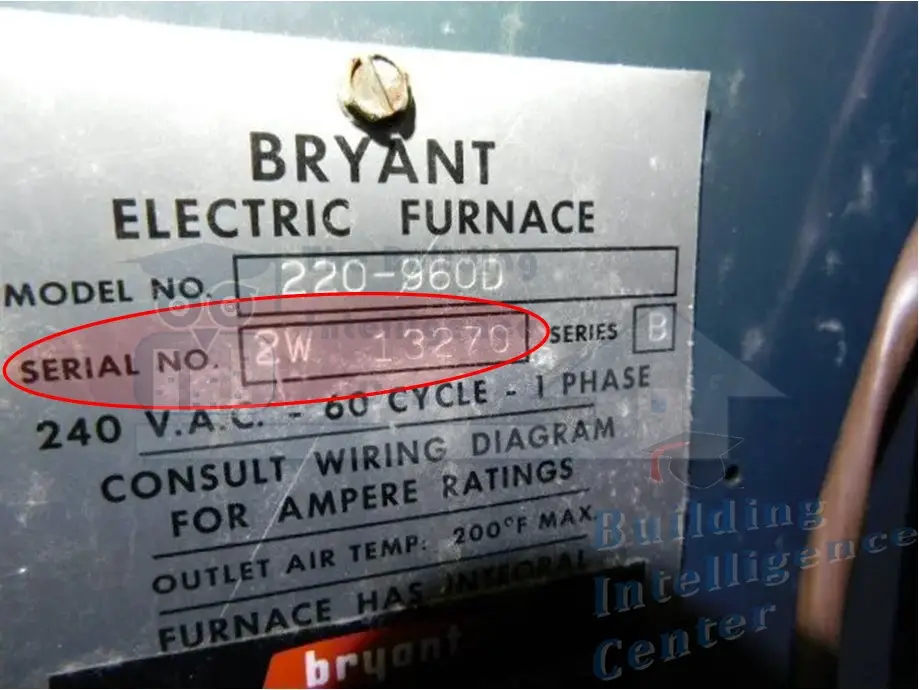
Brand® History¹
-
1881 - Willis Carrier patents the slide rule which was manufactured by Kueffel & Esser. A precursor to the modern calculator, Carrier used this instrument to calculate dew point control - a breakthrough that was the foundation of his invention of modern air conditioning.
1902 - The world’s first modern air conditioning system run by a stationary engine is installed and started by Willis Carrier in the summer of 1902 at the Sackett & Wilhelms printing plant in Brooklyn, New York. This is the invention of modern air conditioning. As a result of his inovations and contributions through the next 50 years, Willis Carrier becomes known as "The Father of Air Conditioning".
1904 - Willis Carrier applies for patent on "Apparatus for Treating Air" He had invented the world's first spray-type air conditioning equipment that could both wash and humidify (or dehumidify) air. The patent was granted and issued in 1906.
1906 - Buffalo Forge Company sells Carrier’s “Apparatus for Treating Air” to the Chronicle Cotton Mills of Belmont, North Carolina, and applies it to the mill’s fan-heater ventilating system. It was the first industrial “central station” humidifying system.
1911 - Willis Carrier publishes "Rational Psychrometric Formulae" which brought science to what had been the often hit-or-miss design of air-conditioning systems, and in the process made Carrier an international name. The chart would be updated and reprinted regularly, serving as an essential tool to generations of engineers and remaining the basis of today’s designs.
1913 - Willis Carrier developed the Carrier Air Humidifier designed to humidify the air in one room, such as an office or laboratory. It was the first self-contained unit with the fan and motor, eliminator, and sprays all combined into a single, packaged product. By 1914,
1914 - By this year, industrial installations designed by Willis Carrier reach from North America to the Middle East, Asia, Europe, and Central and South America. Carrier also achieves the first application of air conditioning in a residence for the Charles Gates mansion in Minneapolis, Minnesota.
1915 - Having so much success across the globe with this new air conditioning technology, Willis Carrier joins forces with 6 other fellow engineers from Buffalo Forge Company to launch Carrier Engineering Corporation, and mass production is started.
1917 - Carrier hires America's first woman engineer - Margaret Ingles who later served on President Herbert Hoover's Conference on Home Building and Home Ownership in the late 1920's, as well as wrote and published Willis Carrier's biography in 1952.
1922 - Carrier unveils the first centrifugal refrigeration machine, more commonly known today as a chiller. This first chiller was installed in Onondaga Pottery Company in Syracuse, New York
1925 - Madison Square Gardens opens. It employs Carrier centrifugal chillers to cool patrons and produce the ice surface for professional hockey.
1926 - T.W. Patterson Building in Fresno, California becomes Carrier’s first multi-story installation with cooled floors two through seven for its tenants. Carrier also introduces the first home air conditioner.
1928 - Milam Building in San Antonio, Texas, included Carrier central air conditioning, making it the first skyscraper to install comfort cooling as it was built.
1930 - Carrier recorded the first sale of its window-sill-height Weathermaster units to the Superheater Company of East Chicago, Indiana, to air condition the second floor of a two-story building. Later that year, the California Bank of Los Angeles contracted for 490 Weathermasters to air condition its 15-story building. The U.S. Supreme Court was also cooled using 180 Carrier Weathermaster units.
1931 - The M.V. Victoria, a 13,400-ton Italian motorship designed to run from Italy to Egypt, became the first vessel to make its maiden voyage equipped with Carrier air conditioning.
1939 - World Fair opens in New York with “Carrier Igloo of Tomorrow” as a major and popular attraction. Inside the Igloo and in the adjacent Hall of Weathermakers, guests learned the steps involved in air conditioning, toured a modern food store using Carrier refrigeration, and viewed an exhibit with Carrier self-contained air conditioning.
1950 - October 7, Willis Carrier passed away. It was the close of an era for both the industry and company, but just the start of an enduring legacy.
1955 - Carrier merged with Affiliated Gas Equipment, Inc., which owned Bryant Heater Co., Day & Night Water Heater Co., and Payne Furnace & Supply Co.
1956 - Carrier won the largest contract ever awarded for residential air conditioning, jointly announced with the community building firm of Levitt & Sons, Inc. Carrier was able to provide Weathermaker central air-conditioning systems for 702 “Country Clubber” homes in Levittown, Pennsylvania.
1968 - Carrier Transicold produces the first front-wall diesel/electric refrigeration unit for shipping containers.
1974 - Carrier creates "BDP" company comprised of Bryant - Day & Night - Payne brands.
1979 - United Technologies Corp. (UTC) acquires Carrier Refrigeration in forced takeover. Carrier becomes a subsidiary of UTC.
1993 - Carrier ceases to manufacture CFC-based chillers in the U.S., two years before the deadline established by the U.S. Clean Air Act.
1990's - Carrier stops using the Day & Night Brand. BDP company still in use.
1999 - Carrier/United Technologies acquires Inter-City Products, and changed the name to International Comfort Products (ICP). Carrier becomes the parent company of ICP, thus incorporating all ICP brands under the Carrier umbrella
2006 - Day & Night brand revived by ICP between 2006-2009 (sources for date vary). Unsure, but presumed to be the end of "BDP Company". Bryant and Payne currently listed under Carrier brands. Day & Night listed under ICP brands.
2011 - Carrier introduced the Infinity® heat pump with Greenspeed™ intelligence offering the greatest heating efficiency of any air source heat pump to date.
2012 - Carrier celebrates the 110th anniversary of the invention of modern air conditioning.
2020 - Carrier completes separation from United Technologies as an independent, publicly traded company - Carrier Global Corporation. The separation process was started in 2018. Carrier retains ICP and their brands.
2022 - Carrier celebrates 120 year anniversary.
1- History excerpts from various sources
